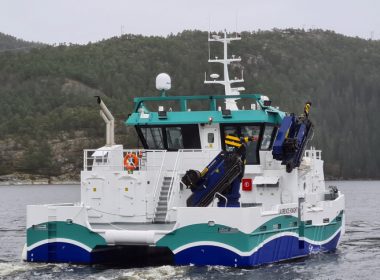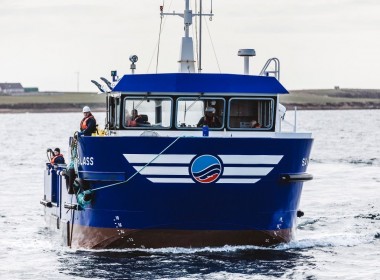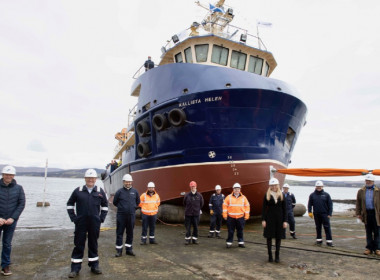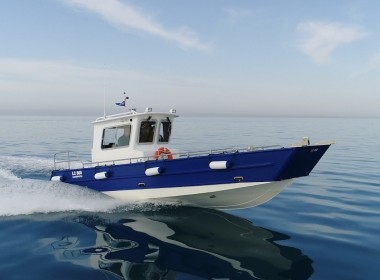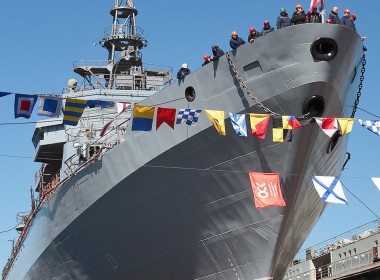VESSEL REVIEW | Hollie Rose – Versatile landing craft for Scottish Sea Farms

Scottish Sea Farms has taken delivery of its largest landing craft to date.
Hollie Rose was built in Scotland by Bute Boatbuilders to a design by Argyll-based naval architect AG Salmon and Co. The vessel is named after the two daughters of Craig Cameron, Scottish Sea Farms’ Mainland Marine Engineering Manager.
“The vessel was designed to support the owner’s move to farms of fewer but larger pens,” Ewen Ferguson, managing director of Bute Boatbuilders, told Baird Maritime. “The vessel’s size will allow the owner to have fewer fish farms without any drop in capacity. Larger and fewer pens create a healthier environment for the fish, freeing up the vessel’s crew to focus on health and welfare.”
The vessel has all-steel construction, an LOA of 19.7 metres, a beam of seven metres, a depth of two metres, and a displacement of approximately 102 tonnes. Up to 45 tonnes of cargo can be transported on the open forward deck. Cargo loading and unloading is aided by a Palfinger Marine knuckle boom articulating crane.
“There is an enclosed elevated deck aft of the working/cargo deck,” said Ferguson. “The deck has raised enclosed foredecks abeam the bow landing ramp and straight-line sheer stepping up to the quarterdeck at the stern.”
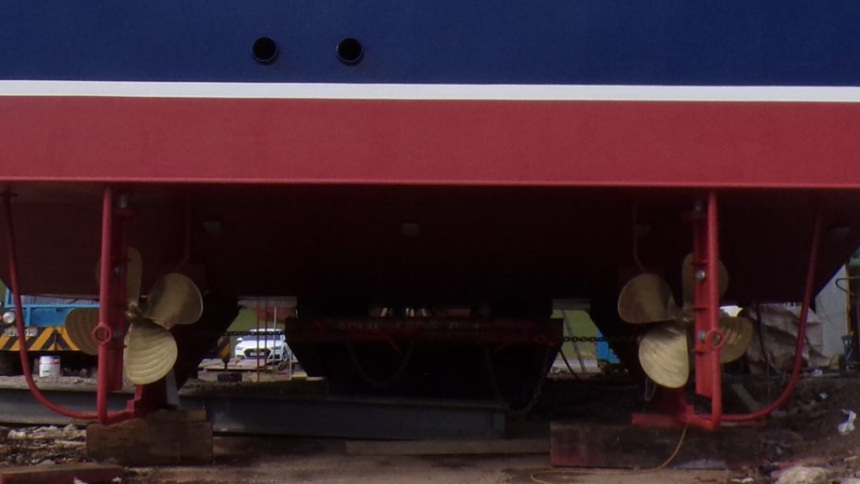
Power is provided by two Doosan MD196TIH water-cooled diesel engines that drive FAL propellers via D-I gearboxes. This arrangement propels the landing craft to a maximum speed of 8.5 knots and a cruising speed of eight knots. The onboard systems are meanwhile fed by two 20kVa silenced AC generators installed between the engines. The generators also have remote start/stop capability and may also be controlled from outside the engine room.
Among the net washing equipment is a remotely operated vehicle (ROV) that removes marine debris from pens during washing, helping create an optimum environment for fish. Ferguson said this is one of the first vessels in Scotland to be equipped with this type of net cleaning technology. The net washing system also has hole detection software that can record any possible damage to the nets, thus further improving containment surveillance.
The electronics suite includes two ICOM fixed VHF radios, a Simrad autopilot, a C-Map plotter, and a radar and a satellite compass from Furuno.
The landing craft has onboard accommodations for two crewmembers. This enables faster reaction times as well as greater flexibility. Cameron said the two crewmembers will work two weeks on and two weeks off.
“The accommodation on board the vessel means there is no need to find housing in rural areas where it is scarce,” Ferguson told Baird Maritime.
The accommodation spaces include two cabins and a galley. LED lighting is used all throughout while paints from International and Chemco were used for the exterior surfaces and water tanks, respectively. The vessel also boasts safety equipment from Ocean Safety and firefighting gear from M&S Fire Protection.
Hollie Rose will be based between Mull and Oban and deployed across Scottish Sea Farms’ mainland estate, where it will assist with net washing, inspections, and treatments.
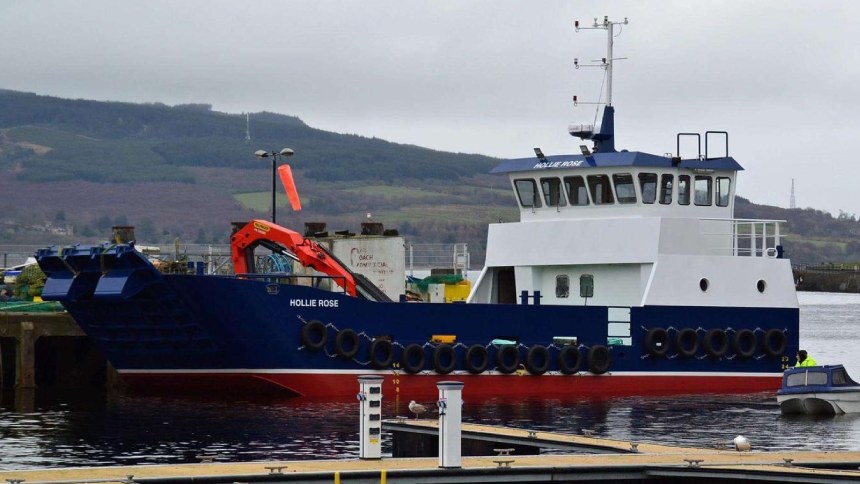
| Hollie Rose | |
| SPECIFICATIONS | |
| Type of vessel: | Fish farm landing craft |
| Flag: | UK |
| Owner: | Scottish Sea Farms, UK |
| Designer: | AG Salmon and Co, UK |
| Builder: | Bute Boatbuilders, UK |
| Hull construction material: | Steel |
| Superstructure construction material: | Steel |
| Deck construction material: | Steel |
| Length overall: | 19.7 metres |
| Length bp: | 16.8 metres |
| Beam: | 7.0 metres |
| Depth: | 2.0 metres |
| Displacement: | 102 tonnes |
| Net tonnage: | 57 |
| Capacity: | 45 tonnes |
| Main engines: | 2 x Doosan MD196TIH |
| Gearboxes: | 2 x D-I Industrial |
| Propulsion: | 2 x FAL propellers |
| Generators: | 2 x 20 kVa |
| Steering system: | D-I Industrial |
| Maximum speed: | 8.5 knots |
| Cruising speed: | 8.0 knots |
| Electronics supplied by: | M B Marine |
| Radar: | Furuno |
| Radios: | 2 x ICOM VHF |
| Autopilot: | Simrad |
| Compass: | Furuno |
| Plotter: | C-Map |
| Crane: | Palfinger Marine |
| Anchors: | 2 x Gaelforce |
| Fendering: | HDPE |
| Other equipment installed: | Howdens galley equipment |
| Paints: | International; Chemco |
| Seating: | Cube |
| Interior lighting: | LED |
| External lighting: | LED |
| Floor surface finishes: | Vinyl |
| Interior furnishings: | Jewson wood panels |
| Safety equipment: | Ocean Safety |
| Firefighting equipment: | M&S Fire Protection |
| Type of fuel: | Diesel |
| Fuel capacity: | 7,500 litres |
| Freshwater capacity: | 500 litres |
| Blackwater capacity: | 300 litres |
| Accommodation: | Cabins; galley |
| Crew: | 2 |
| Operational area: | Western Scotland |



